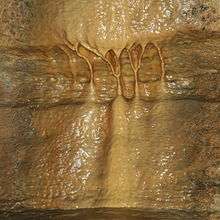Flowstone
Flowstones are composed of sheetlike deposits of calcite formed where water flows down the walls or along the floors of a cave. They are typically found in "solution caves", in limestone, where they are the most common speleothem. However, they may form in any type of cave where water enters that has picked up dissolved minerals. Flowstones are formed via the degassing of vadose percolation waters.[1]
Formation
Flowing films of water that move along floors or down positive-sloping walls build up layers of calcium carbonate (calcite), aragonite, gypsum, or other cave minerals. These minerals are dissolved in the water and are deposited when the water loses its dissolved carbon dioxide through the mechanism of agitation, meaning it can no longer hold the minerals in solution. The flowstone forms when thin layers of these deposits build on each other, sometimes developing more rounded shapes as the deposit gets thicker.
There are two common forms of flowstones, tufa and travertine. Tufa is usually formed via the precipitation of calcium carbonate, and is spongy or porous in nature. Travertine is a calcium carbonate deposit often formed in creeks or rivers; its nature is laminated, and it includes such structures as stalagmites and stalactites.
The deposits may grade into thin sheets called "draperies" or "curtains" where they descend from overhanging portions of the wall. Some draperies are translucent, and some have brown and beige layers that look much like bacon (often termed "cave bacon").
Though flowstones are among the largest of speleothems, they can still be damaged by a single touch. The oil from human fingers causes the flowing water to avoid the area, which then dries out. Flowstones are also good identifiers of periods of past droughts, since they need some form of water to develop; the lack of that water for long periods of time can leave traces in the rock record via the absence or presence of flowstones, and their detailed structure.[1]
Uses
Cave onyx is any of various kinds of flowstone considered desirable for ornamental architectural purposes. "Cave onyx" was a common term in certain areas of the United States—particularly the Tennessee-Alabama-Georgia area and the Ozarks—during the 19th and early 20th centuries, being applied to calcite speleothems that were banded in a way suggestive of true onyx.
There are a number of US caves called "Onyx Cave" because of the presence in them of such deposits.
Gallery
References
- 1 2 Drysdale, Russell; Zanchetta, Giovanni; Hellstrom, John; Maas, Roland; Fallick, Anthony; Pickett, Matthew; Cartwright, Ian; Piccini, Leonardo (2006). "Late Holocene drought responsible for the collapse of Old World civilizations is recorded in an Italian cave flowstone". Geology 34 (2): 101. doi:10.1130/G22103.1.
External links
 |
Wikimedia Commons has media related to Flowstones. |
|
|---|
| | | | Main topics | |
|---|
| Types and formation
processes | |
|---|
| Speleothems
and Speleogens
(Cave formations) | |
|---|
| | | Africa | |
|---|
| | Americas | |
|---|
| | Asia | |
|---|
| | Europe | |
|---|
| | Oceania | |
|---|
|
|---|
| | Cave dwellings | |
|---|
|

.jpg)
.jpg)
.jpg)
.jpg)